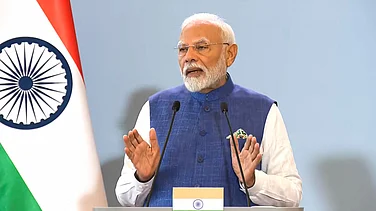In early September 2021, television screens across the country flashed footage of fighter jets soaring over mountain terrain—purportedly Pakistani airstrikes pounding Afghanistan라이브 바카라 Panjshir Valley. Republic World touted the clip as an 'exclusive,' citing a channel called Hasti TV, and declared that a Pakistani jet had attacked the valley and killed a resistance spokesperson. Times Now Navbharat and Zee Hindustan quickly followed, framing the same footage as definitive proof of Pakistan's military involvement.
The source video, however, originated not from Panjshir but from a military video game called ARMA 3. It had been uploaded by Hasti TV, a little-known broadcaster reportedly based in the UK, which had captioned it with caveats, noting that 'official sources have not approved this video.' Fact-checking site Alt News later confirmed the footage라이브 바카라 true origins. But by the time corrections trickled in, the disinformation had already saturated prime-time programming and social media feeds.
No editor was suspended. No newsroom faced sanctions. No real accountability was taken. The decision to run the video without any concrete verification was not just an editorial lapse. It revealed an alarming collapse of protocols in India's media landscape, where the manufactured spectacle routinely eclipses journalistic due diligence. Any source can be taken as fact so long as it serves a narrative. In a media ecosystem driven by competition for virality, the fake had served its purpose: it had filled airtime and stoked nationalist outrage. India's disinformation crisis is no longer limited to anonymous WhatsApp forwards or fringe conspiracy blogs. It is institutional, infrastructural, and increasingly profitable.
As of 2025, India ranks 151st (out of 180 countries) on the World Press Freedom Index. A decade ago, it ranked 140th. The fall is not accidental; it reflects a deliberate weakening of journalistic institutions. In place of independent reporting, media houses rely on syndicated wire content. And when the source is Asian News International (ANI)— a private agency known to be pro-government—the line between news and state propaganda collapses entirely.
—the line between news and state propaganda collapses entirely.
Press Trust of India (PTI), the other dominant wire agency, is considered more cautious, but even its reports are often carried without secondary checks. The industry standard then, is one where in an agency's error can become a national consensus within a matter of hours.
The digital era has brought new challenges to newsrooms across the world. The incentives have shifted. Editorial value has been replaced by traffic metrics. Reporters are judged by clicks, not corrections. In 2024, a fabricated quote attributed to Karnataka Congress MLA Priyank Kharge—warning of "bloodshed" if the BJP returned to power—circulated on X and WhatsApp. All through it was debunked, but it was not before it shaped news debates and dominated the election narrative for days. This is just one of the many cases in which Social media platforms have supercharged this dynamic.
Facebook라이브 바카라 internal audits revealed that its algorithms pushed Indian users toward incendiary content. In 2024, Global Witness submitted a report citing 48 false political ads to YouTube in Indian languages—most were approved. WhatsApp, India라이브 바카라 most widely used messenger, remains a primary vector for misinformation, especially in regional languages where content moderation is minimal.
Rather than reforming this environment, the state has chosen to regulate speech. In 2023, amendments to the IT Rules granted the government라이브 바카라 Press Information Bureau the power to label online content as “fake” and demand its takedown. The Editors Guild of India called it censorship by another name. Although the Bombay High Court struck it down as unconstitutional, journalists reported that the rule had already chilled coverage.
The same year, the Digital Personal Data Protection Act allowed the government to exempt its agencies from disclosure requirements. The Press and Registration of Periodicals Bill introduced vague “security” clauses that could be used to deny registration to independent publications. Together, these laws signal a shift: from the regulation of media to its control.
There is precedent. The colonial state enacted gag laws like the Vernacular Press Act (1878) and the Press Act (1910) to criminalise dissent. Post-independence India adapted these instruments. During the Emergency (1975–77), Indira Gandhi라이브 바카라 government suspended civil liberties and imposed full-spectrum press censorship. The Indian Express responded with a blank editorial. Today, the silencing is ambient—enforced not by the censor라이브 바카라 red pen, but by throttled reach, algorithmic bias, and bureaucratic scrutiny.
Disinformation has also become a tool of communal mobilisation. In August 2024, a gruesome video showing a man being attacked with an axe circulated on social media with the false claim that it was a Muslim mob targeting Hindus in Bangladesh. While the violence in the video was real, it was later revealed that it was not religiously motivated but rather over a land dispute. This pattern re-emerged in the media라이브 바카라 coverage of the 2025 terror attack in Pahalgam, where sensationalised claims and communal framing outpaced verified facts and on-ground reporting.
Independent fact-checkers like Alt News and Boom continue to publish fact-checks daily. Mohammed Zubair, co-founder of Alt News, was arrested in 2022 over a tweet. In Kashmir, where the state라이브 바카라 heavy-handedness is most visible, journalists Aasif Sultan and Irfan Mehraj remain detained under the Unlawful Activities Prevention Act—an anti-terror law increasingly used to criminalise critical reporting. Sultan was granted bail in 2022, only to be re-arrested. Mehraj was arrested for alleged links to a human rights NGO critical of the state. Rights organisations, including the Committee to Protect Journalists, have condemned these arrests as politically motivated.
India라이브 바카라 current information disorder did not emerge in a vacuum. It is the product of institutional erosion, technological acceleration, and political utility. Misinformation does not spread because people are uninformed, but because lies are often more emotionally resonant and algorithmically rewarded than complex truths. In a media economy driven by outrage and engineered for speed, fiction is more profitable than fact.


















